Up a tad. Down from the highs but still troublingly high.
Leveling off is not a good thing for the Fed.
Central bank liquidity swaps (13) $389,671+ $880
[top]

Up a tad. Down from the highs but still troublingly high.
Leveling off is not a good thing for the Fed.
Central bank liquidity swaps (13) $389,671+ $880
[top]
This has been making the rounds and is not impossible:
But European banks may be in far worse shape. Bruno Waterfield of the London Daily Telegraph reports to have seen an eyes-only document prepared by the European Commission for the finance ministers of the various EU member countries. The problem revealed in the report is an estimated write-down by European banks in the range of 16 trillion pounds, or about $25 trillion dollars! The concern is that bailing out the various national banks for such an unbelievable amount would push the cost of government borrowing to much higher levels than we see today.
As my kids would say, “Really, Dad, you think so?” Europe is somewhat larger than the US, so think what my gold-bug friends would say if the US decided to borrow $25 trillion to bail out US banks. The dollar would be crucified! The euro is going to get a lot weaker if bank problems are even half of what the report says they are. The British pound sterling is already off almost 30% and, depending on what the real damage is to their banking system, it could get worse.
Waterfield reports, “National leaders and EU officials share fears that a second bank bail-out in Europe will raise government borrowing at a time when investors — particularly those who lend money to European governments — have growing doubts over the ability of countries such as Spain, Greece, Portugal, Ireland, Italy and Britain to pay it back.
I’m not too worried about the UK. but the eurozone banks and national governments are at risk.
In fact, they may have failed last fall when the Fed stepped in with unlimited USD swap lines (could turn out to be fiscal transfers?) to the ECB to buy them some time.
Unfortunately it all gets a lot worse as the eurozone GDPs melt down.
“The Commission figure is significant because of the role EU officials will play in devising rules to evaluate ‘toxic’ bank assets later this month. New moves to bail out banks will be discussed at an emergency EU summit at the end of February. The EU is deeply worried at widening spreads on bonds sold by different European countries.”
Part of the problem is that European banks were far more highly leveraged than US banks. Some banks were reportedly leveraged 50:1. And they lent money to Eastern European projects and businesses which are now facing severe financial strain and plummeting local currencies.
Let that number rattle around in your head for a moment: $25 trillion. Even $5 trillion would be daunting. But the problem is that Europe does not have a central bank that can step in and selectively save banks from one country without taking on all euro zone member-country banks. Yet, as noted above, some countries may not have the wherewithal to save their own banks. It is reported that some Austrian banks are hoping that Germany will step in and help them. Given Germany’s problems, they may have a long wait.
[top]
But not a full payroll tax holiday to stop removing $230 billion a week of income.
From people and businesses struggling to meet their payments?
Summers Says Obama Mortgage Plan to Focus on Lowering Payments
by Rich Miller and Matthew Benjamin
Feb 14 (Bloomberg) — The White House is willing to spend more than the $50 billion already pledged to stem home foreclosures and intends to focus its efforts on reducing monthly mortgage payments, rather than principal, saidLawrence Summers, the president’s top economic adviser.
“We’re prepared to do what is necessary,” Summers said in an interview on Bloomberg Television’s “Political Capital with Al Hunt” yesterday. “Going directly at the problem means addressing affordability by addressing payments.”
[top]
It all came to a near halt with the world wide inventory liquidation. Now flows are resuming but will be at lower levels than before, reflecting lower demand.
Prices should recover over time to something above replacement costs.
Look for deteriorating real terms of trade for the US as the modest fiscal adjustment adds to demand, and import prices grow faster than export prices, led by Saudi crude pricing.
Shipping Index Surge Signals Commodity Currency Gains
by Ye Xie and Candice Zachariahs
Feb 17 (Bloomberg) — Shipping costs have more than doubled this year, so it may be time to buy kroner, Aussies and loonies.
The 147 percent jump in ocean-transport prices is evidence that China’s $580 billion stimulus plan will lift raw materials, said Ihab Salib, who oversees $3 billion at Federated Investments Inc. in Pittsburgh. That would benefit countries exporting them, so Salib is “actively trading” Norway’s krone and Australian and Canadian dollars, nicknamed Aussies and loonies.
Salib and other currency traders have started using the Baltic Dry Index’s global gauge of raw-material shipping costs to help make such decisions. The index and the value of a basket of those three resource-rich countries’ currencies are increasingly moving in tandem — 96 percent of the time in the past year, up from 84 percent in the past decade, data compiled by Bloomberg show.
“Historically, the Baltic Dry Index is a good leading indicator for commodity prices,” said Salib, who declined to detail his investments. “Commodities are very depressed right now, and they offer good long-term value. Once they come back, these currencies should do well.”
The shipping gauge is a sign that China’s stimulus spending on housing, highways, airports and power grids will have impact beyond its borders. By Feb. 28, it will have spent 25 percent of its stimulus budget, Deutsche Bank AG said Jan. 20, predicting the country’s economy will grow at a 12 percent annual rate between the fourth and first quarter, after shrinking 2.3 percent between the third and fourth.
Oil Rebound
China is the world’s biggest consumer of copper and iron ore and has helped each rally this year by about 10 percent, benefiting Australia and Canada, which account for 10 percent of world production of the two metals. Oil,Norway’s top export, will average $66 a barrel in the fourth quarter, up from an average of $40.62 since Jan. 1, according to the median forecast of 34 analysts surveyed by Bloomberg. China is the world’s second-biggest energy user.
[top]
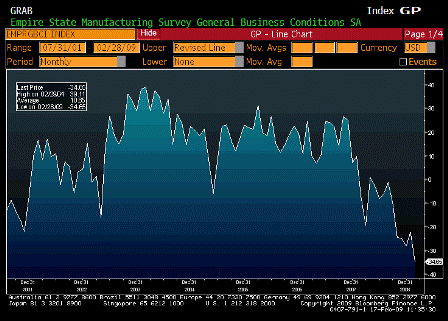
| Survey | -23.75 |
| Actual | -34.65 |
| Prior | -22.20 |
| Revised | n/a |
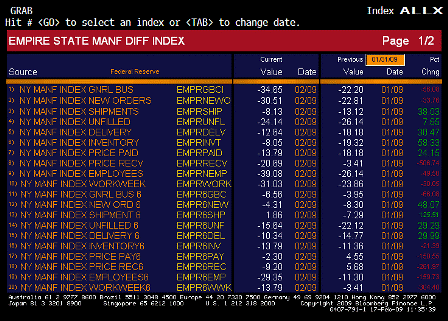
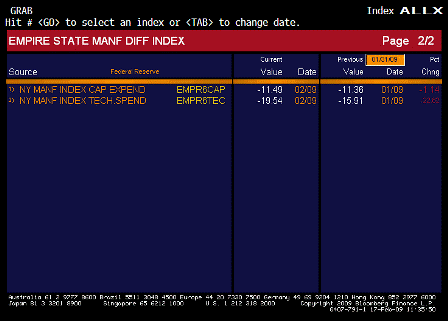
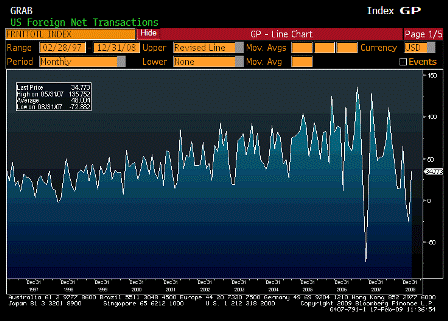
| Survey | $20.0B |
| Actual | $34.8B |
| Prior | -$21.7B |
| Revised | -$25.6B |
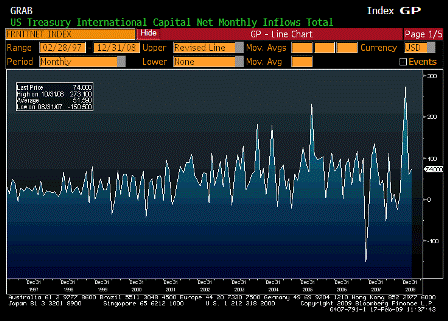
| Survey | n/a |
| Actual | $74.0B |
| Prior | $56.8B |
| Revised | $61.3B |
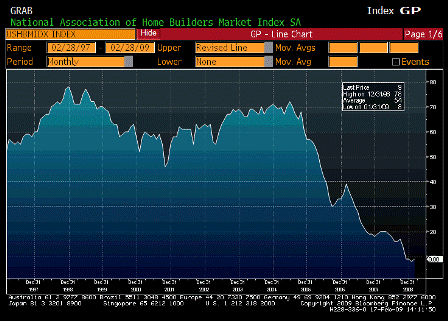
| Survey | 8 |
| Actual | 9 |
| Prior | 8 |
| Revised | n/a |
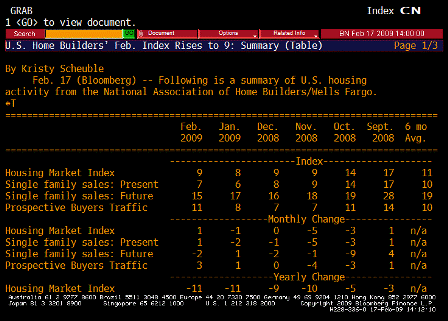
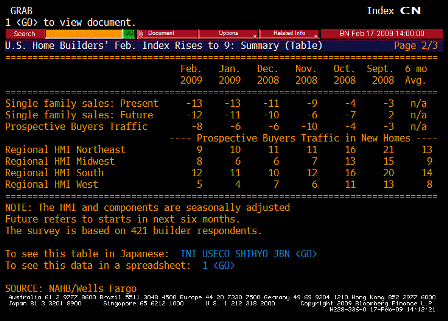
[top]
Some recent widening with the deteriorating economy.
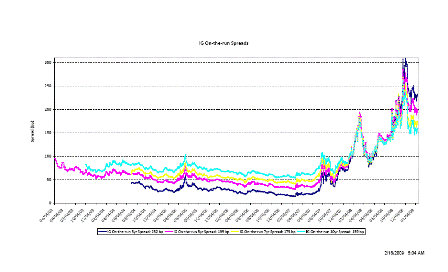

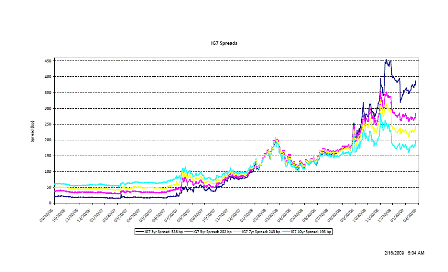
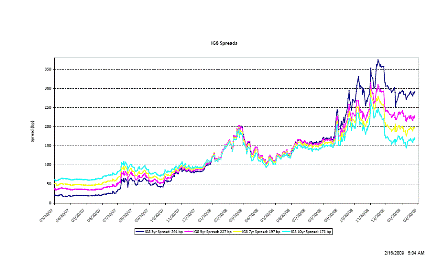
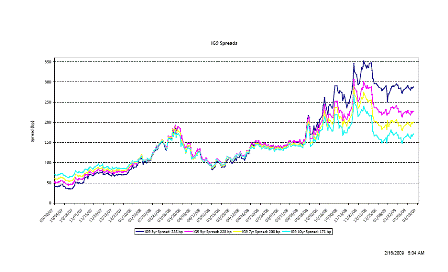
[top]
China’s Economy Shows Signs of Recovery on Stimulus
by Kevin Hamlin
Feb 13 (Bloomberg) — “China looks set to be the first major economy to recover from the current global meltdown,” said Lu Ting, an economist with Merrill Lynch & Co. in Hong Kong. “China is the only economy in the world to see significant growth in credit to corporate and household sectors after September 2008, when the financial crisis worsened to a near collapse.”
State owned banks lending without all that much regard to credit quality functions like a fiscal transfer.
The government’s stimulus plan, announced in November, is beginning to gather momentum. Projects such as the building of 3.5 billion yuan of public houses in Shaanxi province and Shanghai began in December, while Shandong province started work on three new railway lines the same month.
China is committing about 1.2 trillion yuan of central government funds to the plan, which means banks’ willingness to fund projects is crucial. So far they are responding.
Housing construction is real investment.
Growth will accelerate from the current pace to 7.2 percent for the full year, according to Wang Qian, an economist with JPMorgan Chase & Co. in Hong Kong. Her calculation is that consumption will contribute 4.4 percentage points and investment 4 percentage points. The collapse in exports will slice off 1.2 percentage points.
Stimulus spending will contribute up to 3 percentage points of the total, she estimates.
Still low growth for China.
China’s imported iron ore has climbed 28 percent to 690 yuan per metric ton since the end of October. Hot-rolled steel has surged 41 percent from Nov. 13 to 4,027 yuan per metric ton. The Baltic Dry Index, a measure of shipping costs for commodities, has more than doubled since Jan. 28.
“You are starting to see the underlying demand of the Chinese economy,” BHP Billiton Ltd. Chief Executive Officer Marius Kloppers said Feb. 4. “We have seen in the steel business in China that the de-stocking cycle is almost complete and that means people are coming back into the market and buying.”
BHP Billiton is the world’s third-largest producer of iron ore. China is its largest consumer.
The post-Olympic lull is over?
[top]
1. The size of the TALF from $200bn to $1 trillion is a very big deal. It requires no Congressional approaval and the Fed seems ready to start buying assets this week or next. Not only will this Fed buying guarantee a revival of many securitised credit markets, but the 10 to 1 Fed leverage in the TALF structure will result in a huge expansion of the Fed’s balance sheet, which ought to be good news from a money supply point of view.
The ‘money supply point of view’ is meaningless with non convertible currency. In fact, adding to the Fed’s portfolio takes income from the rest of us. A $5 trillion portfolio with a 3% coupon removes $150 billion a year in private sector income, for example. Any good the lower interest rates do can be more than offset by the removal of interest income.
2. The public-private partnership (PPP) for acquiring toxic assets is simultaneously too complicated and lacking in detail. But a couple of things do seem clear: This will effectively be a “bad bank” designed to “cleanse” $1 trillion worth of “legacy” assets from bank balance sheets. The surprising element is that Geithner thinks he will be able to capitalize this bad bank partly with private money. This presumably implies that the toxic assets will enjoy some pretty generous government guarantees, which ought to be good news for existing bank shareholders.
Yes, investors will benefit risk free which adds nothing to aggregate demand, meaning unemployment will remain high and borrowers continue to struggle with their payments, while investors profit. And this is from the far left!
An alternative possibility is that the PPP will buy toxic assets very cheaply (which would of course be bad news for the disposing banks. This seems unlikely however because of the third and most important element explicitly stated in the Treasury’s background briefing, though not mentioned by Geithner in his speech (presumably because he did not want to sound like he was being too generous to the banks):
3. A Financial Stability Trust (FST) will inject convertible “contingent equity” into banks once they have cleansed their balance sheets by selling toxic loans to the PPP. This contingent equity will be available in unlimited amounts to banks with consolidated assets of over $100 billion. The most crucial point is that pricing looks very generous. “The conversion price [will be] set at a modest discount from the prevailing level of the institution’s stock price as of February 9, 2009”. In other words, if a bank needs to raise additional equity from the US government, this equity will be priced in line with this week’s market values and will not be grossly dilutive to existing shareholders like the capital injections into Fannie and AIG. This seems very generous to bank shareholders, especially as the Treasury is offering to buy bank equity at this price in unlimited amounts (although looking at the performance of US regional banks yesterday, the market clearly took a different conclusion).
More funds for the investor class.
4. Another generous element of the FST package is the approach to “stress testing” bank balance sheets: “The Treasury Department will work with bank supervisors and the Securities and Exchange Commission and accounting standard setters in their efforts to improve public disclosure by banks. In conducting these exercises, supervisors recognize the need not to adopt an overly conservative posture or take steps that could inappropriately constrain lending.” In other words, banks will be allowed to continue using “hold to maturity” accounting, if the alternative is “overly-conservative” accounting which “inappropriately constrains lending”.
5. Finally, the purpose of the Treasury stress-tests will be to establish whether banks have enough capital to continue sufficient lending even “in a more severe decline in the economy than projected”. After these stress-tests, the Treasury will effectively insure banks against such a deeper-than-expected recessions by providing a “guaranteed buffer” of contingent capital (as described in 4 above). In other words, it looks as if the Treasury will provide a catastrophe insurance policy against a deeper than expected recession, probably at a pretty low price to the banks (certainly at a much lower price than infinity, which is what an insurance policy against economic depression would cost in the markets today).
And yet another distribution to the investor class.
This is trickle down economics that would make even Reaganites blush.
Seems working people have no representation whatsoever.
[top]
A lot of this is the front month getting hurt technically by the futures funds caught in the nearby months with massive rolls to do each month.
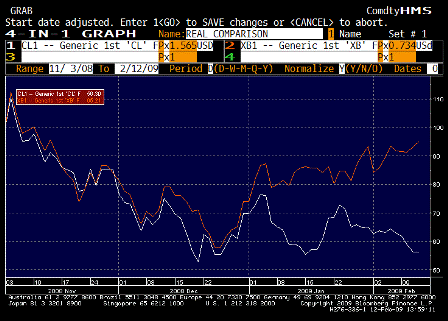
[top]
(email exchange)
As I’ve said all along, the problem is best addressed from the bottom up- restore incomes and employment via a payroll tax holiday and a check for $300 billion for the states.
That ends the financial crisis and its effect on the real economy.
Then Congress attempt to rationally address other fiscal action on its merits beyond fixing the crisis.
>
> On Thu, Feb. 12, Morris wrote:
>
> Part of the problem the banks confront is that their
> loans continue to deteriorate. This limits their ability
> to initiate new loans, makes them tighten lending
> standards and clouds their business visibility. The
> proper visual is a ship taking on water while the
> crew is trying to bail out the ship. If the ship takes
> on water too quickly it will sink, if the crew can plug
> the whole and bail out the ship the ship will float.
> This is state of affairs of most banks at the
> moment. The ultimate success of these bailouts &
> workouts will take hold when the rate of credit
> deterioration slows or stops.
>
Ross Says Investors Will Wait for Bank Writedowns
by Jason Kelly and Carol Massar
Feb 12 (Bloomberg) — Wilbur Ross, the billionaire investor who focuses on distressed assets, said private funds won’t join President Obama’s plan to buy toxic mortgages until banks reduce the value of the
securities on their books.
“The reason the assets haven’t changed hands is they haven’t been
properly marked,” Ross said in an interview with Bloomberg Television
yesterday at his New York office, referring the process of valuing investments based on market prices. “His idea of doing public/private partnerships is correct. The private sector is very good at price
discovery.”
[top]